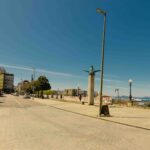Despite the fact that a project by F.Conde-Valvís came into existence in 1937 (see Conde-Valvís, 1975) and a frustrated attempt to obtain the concession by the company “Agrícola de Antela, S.A.” (see Zapata Tejedor, 1967), the lagoon of Antela survived during the first half of the 20th century despite the concessions, aid, subsidies (up to 50 % of the budget) and tax exemptions provided for by the Law of 24 July 1918, promulgated by Alfonso XIII, with Francisco Cambó as Minister of Development, for “any private corporation or company domiciled in Spain” that had promoted “the drainage and sanitation of lagoons, marshes and swampy or flooded land, provided that the area drained or sanitized was greater than 100 hectares”.
It can be deduced that the extensive official facilities were not enough to attract private initiative again to a project for the drainage of Antela, probably because of doubts about the economic profitability and viability of the project in view of the series of failed attempts throughout the 19th century.
Law 1956 on drainage of Antela
“It was therefore essential for the State to act”, Francisco Franco promulgated the “Law of 27 December 1956 on drainage and colonisation of the lagoon of Antela, located in the province of Ourense” which ordered “the conquest for agricultural and livestock production of the lands of the Antela Lagoon” to the National Institute of colonisation, created in 1939.
1528 words were enough to end up with the Lagoon of Antela
Law 1956 for the drainage of Antela is brief (13 articles, 113 lines, 1528 words, highlights the agricultural and livestock interest in drainage and does not make any reference to human health problems. The law estimates the surface area to be drained at “around 4000 ha” (overestimating it by 750 ha), erroneously including Porqueira in the list of town councils to which Antela belongs, and it obviates any reference to the environmental values and traditional economic uses of the lagoon that would not be lost. Although the law preamble states that it establishes “the precepts necessary to solve the problem in its legal and technical aspects”, it focuses on the former and omits the latter, which are postponed until the delimitation of the surface to be drained and the elaboration of the General Plan for colonisation and the Coordinated Plan for Necessary Works, which will have to be executed by the Ministries of Public Works and Agriculture.
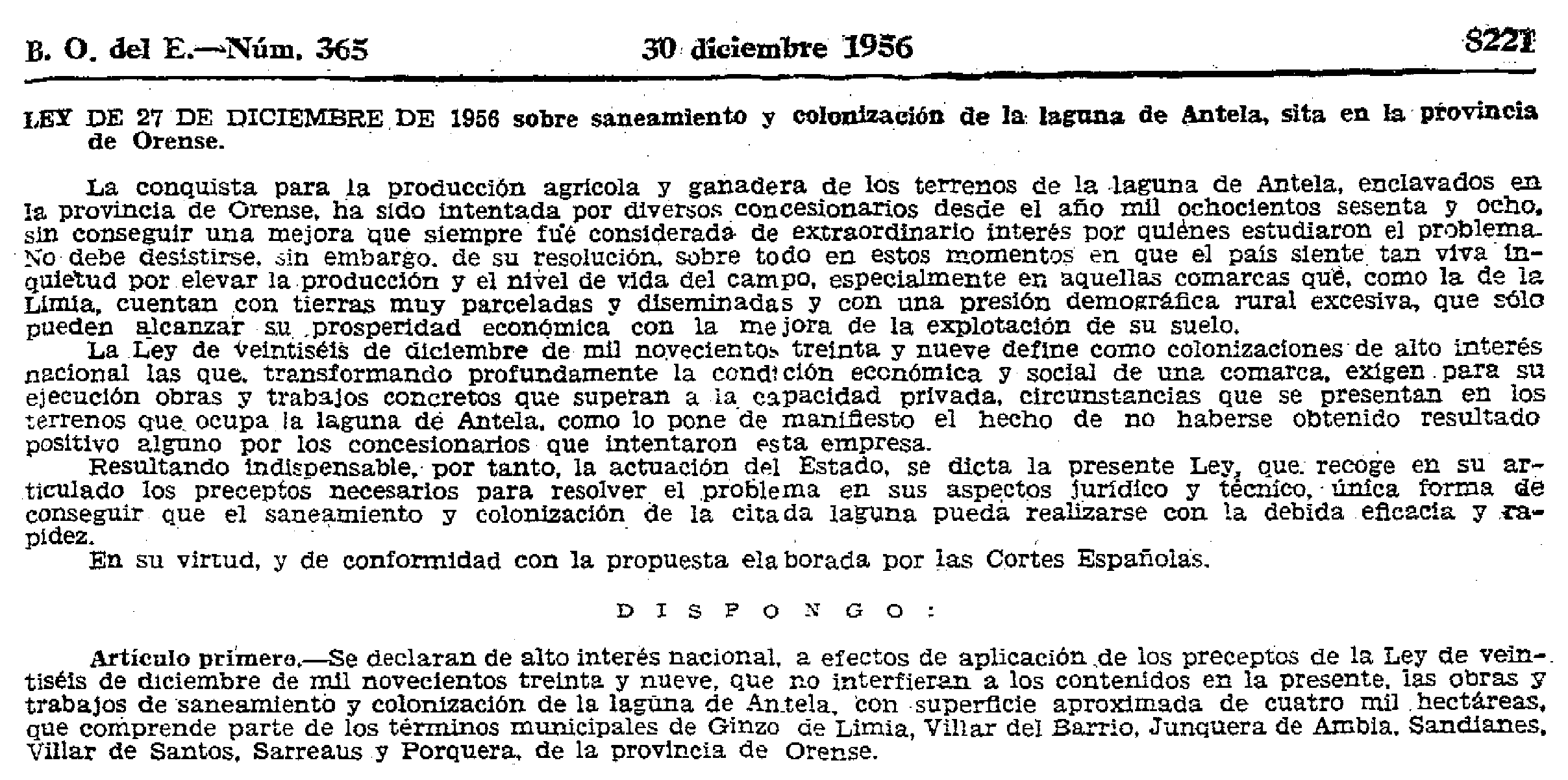
Law of 27 December 1956 on the drainage and colonisation of the lagoon of Antela
Theoretical planning of actions
A LLaw 1956 on the drainage of Antela established the following actions:
- Preparation of the proposal for the delimitation of the land to be drained within a period of two months (art. 2).
- A subsequent period of one month for complaints by the interested parties (art. 3).
- Approval of the final proposal for the delimitation of the land to be drained (art. 4).
- Drafting of the General Colonisation Plan, which will include the “Listing of the works necessary for the sanitation and colonisation of the delimited area” (art. 8).
- Approval by Decree of the General Plan for Colonisation, which will establish the term to elaborate the “Coordinated Plan for Necessary Works for the drainage and colonisation of the delimited surface: a) Constructive characteristics… b) Determination of the ones that correspond to build… the Ministry of Public Works and the National Institute of Colonisation, and c) Order and rhythm to which the projects and execution of the works should be adjusted” (art. 9).
The project of the drainage of Antela
A project elaborated in 2 months!
To comply with the 1956 Law for the drainage of Antela, in June 1957 the National Institute of Colonisation commissioned the project to the Civil Engineer Francisco Zapata Tejedor, who carried it out within the required period of two months. However, he expressly stated in the project’s report that “due to the time constraints and the limited soil surveys, the proposed solution was perfectible” and included a quote from Terzaghi about “good engineering requires the following procedure when dealing with soil hydraulic problems: the project is executed on the basis of the results of an investigation, but care is taken during the construction period and, if necessary, during several years thereafter, observations are made on site, to determine whether, and to what extent, the actual soil conditions differ from those assumed” (Zapata Tejedor, 1967).
The project was echoed in the minor work “Twenty years of peace in the National Movement under Franco. Province of Orense” (Anonymous, 1959) in the following terms: “Taking into account all the efforts previously made, which generally failed due to lack of elements, and the enormous political, economic and social interest represented by the rescue of the lands that make up the Antela Lagoon, the Government of Generalisimo Franco promulgated the so-called “Law of the Antela Lagoon” by which the area of the Lagoon was declared of High National Interest and the regulations by which this enterprise should be governed were dictated”.
Choices considered
According to the document “Twenty years of peace in the National Movement under the command of Franco. Provincia de Orense” (Anonymous, 1959) and the one indicated by Zapata Tejedor (1967), the possibility was considered of draining Antela (located at an altitude of 620 m above sea level) by transferring the water to the River Arnoia (altitude of 600 m above sea level) through a series of tunnels. However, this alternative was discarded due to its greater cost and because it would subtract the water from 162 km2 of the basin at its headwaters to the River Limia. In the end, a project was chosen to drain Antela, similar to what had been attempted since the time of the Toubes Corregidor (see Bedoya, 1831), 130 years earlier.
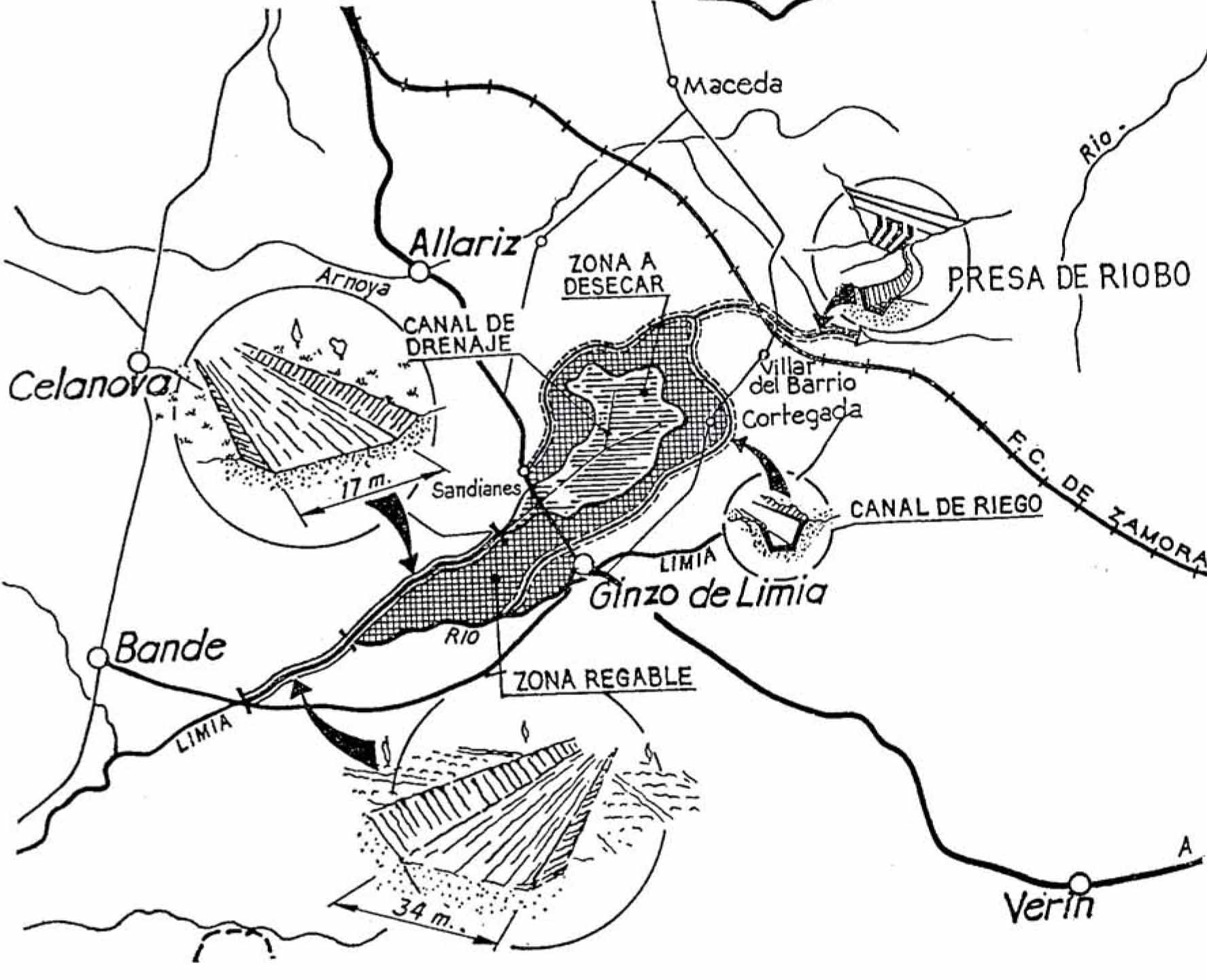
Esquema do proxecto de desougamento 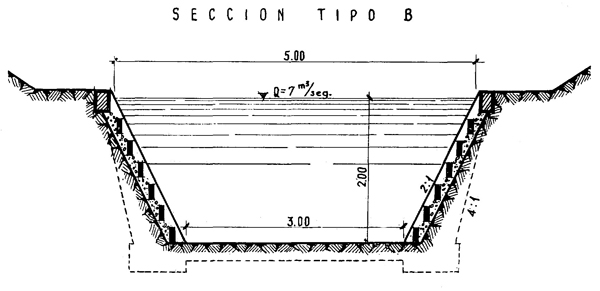
Sección do canal-dren máis estreito
Project phases
The project elaborated by Zapata Tejedor had three phases:
- First phase. Drainage of the lagoon, which included the channelling of the lower stretch of the Limia River (with a channel 3.5 km long and 34 m width) and the Lagoon Outfall to the Limia River (with a channel more than 7 km long and 17 m width), as well as the construction of the network of main drainage channels in the lagoon itself with a total length of 11 km and 4-9 km in length.
- Second phase. Transformation into irrigation, which included a dam at the headwaters of the Arnoia River in Riobó, 9 km of transfer channel from the Arnoia River to the Antela Plain and 42 km of irrigation channels.
- Third phase. Colonisation of the “rescued” lands.
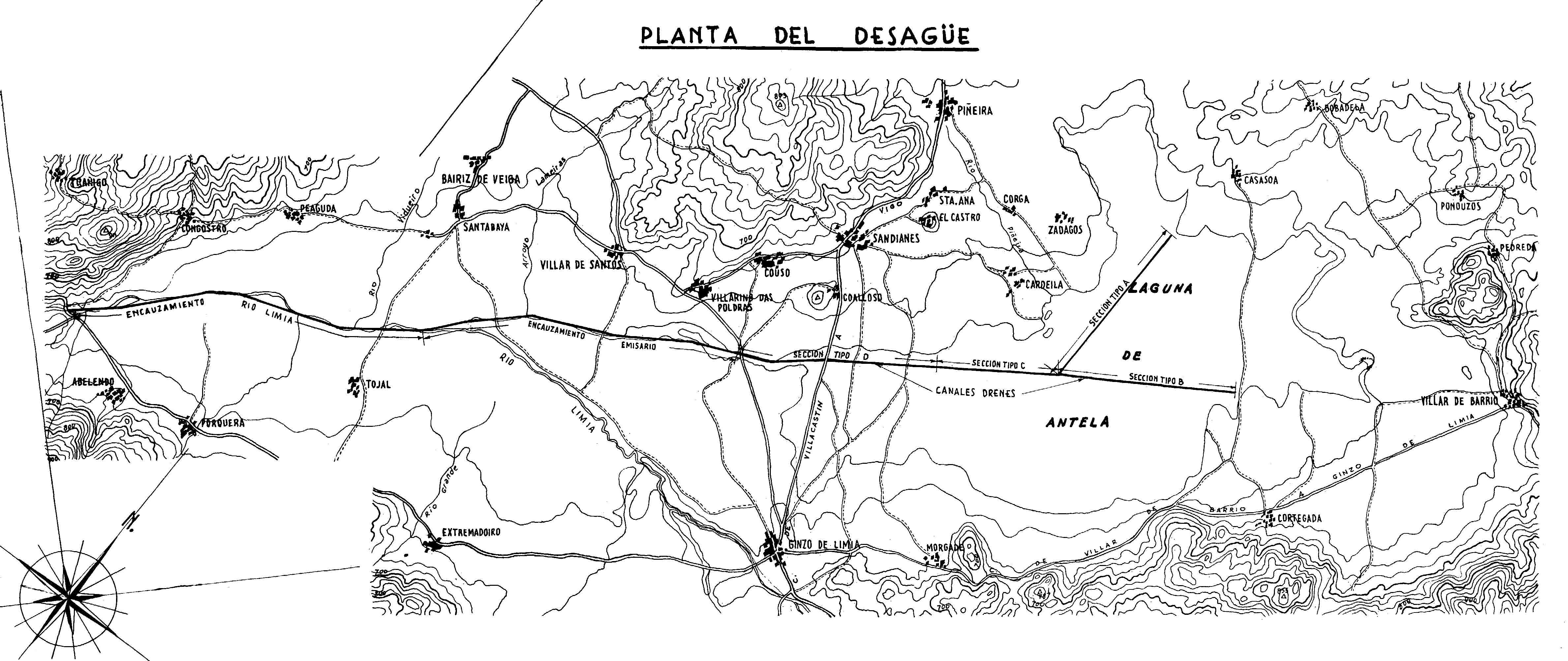
Scheme for the drainage of the Antela Lagoon according to the project carried out in 1957 by the engineer Francisco Zapata Tejedor.
Start of work
Despite the fact that the delimitation of the land to be drained, the General Plan of Colonisation and, therefore, the “Coordinated Plan of Works necessary for the sanitation and colonisation of the delimited surface” established by the Law of 1956 for the drainage of Antela, were still lacking, the works that finally led to their disappearance began on September 17, 1958.
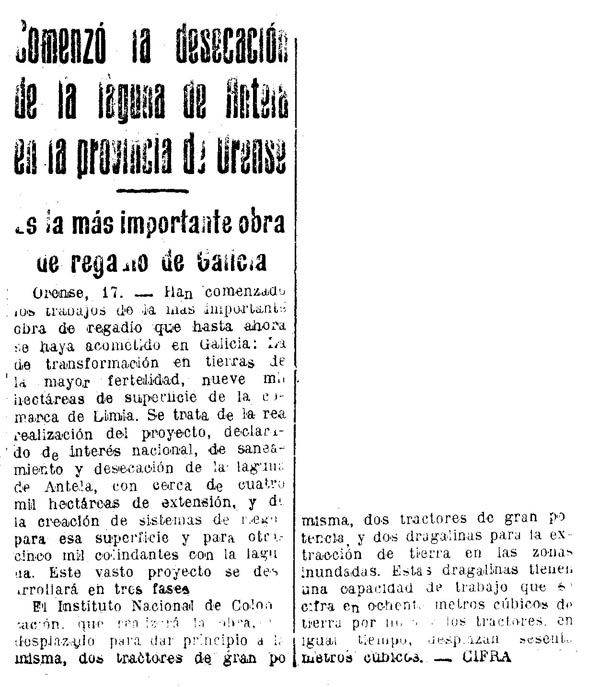
La Voz de Galicia 18-09-1958 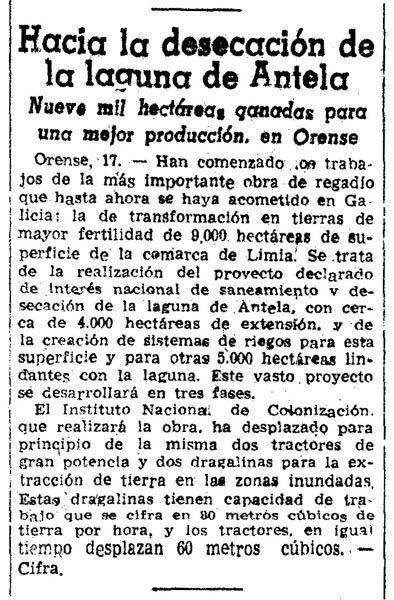
La Vanguardia 18-09-1958
The following images, reproduced in the book of Martínez Carneiro, X.L. (1997) Antela, a memoria asolagada, by courtesy of Edicións Xerais, show several phases of the execution of the project elaborated to comply with the Law 1956 for the drainage of Antela.
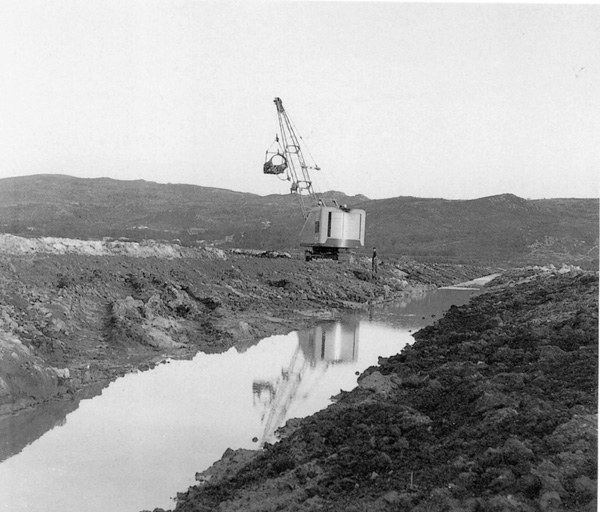
Draga traballando nun canal
Dredger working on a canal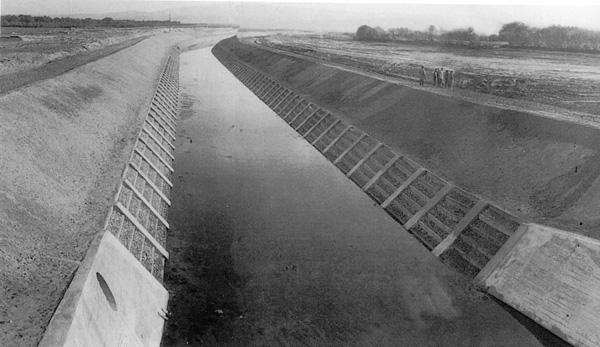
Canal principal na chaira de Antela
Main canal of the Antela floodplain
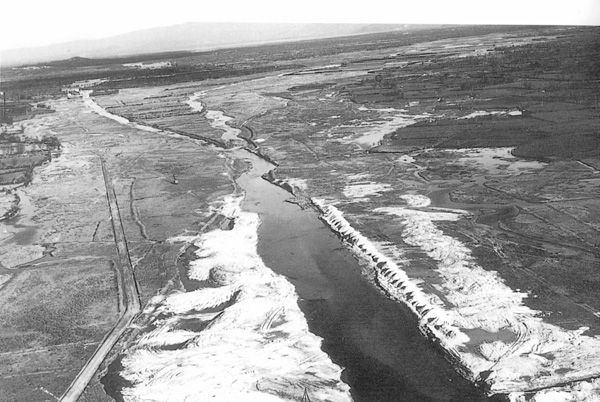
Emisario de Antela sen canalizar
Unchannelled Antela Emissary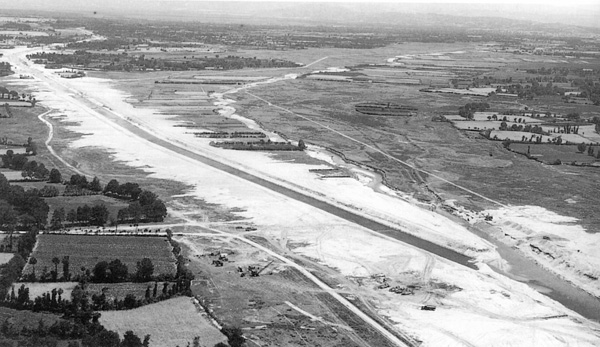
Emisario de Antela canalizado
Channelled Antela Emissary
1962: the drainage ends
The drainage works advanced until in May 1962 the definitive drainage of Antela was started (although the channelling works were still “almost finished” in 1963 according to Zapata Tejedor, 1967). Meanwhile, the three months set aside to delimit the land to be drained became almost six years, until Decree 2336/1962, of 20th September, approved the definitive delimitation and set the surface area of Antela at 3243.76 ha:
- 54.44 ha of private property.
- 2161.33 ha of private and communal property “but subject to expropriation in accordance with article seven of the Special Law of the Lagoon”.
- 1027.97 ha of public domain.
In its article 3, the Decree 2336/1962 establishes that “by the National Institute of Colonisation, the General Plan of Colonisation will be drawn up in accordance with article eight of the aforementioned Special Law of the Antela Lagoon”.
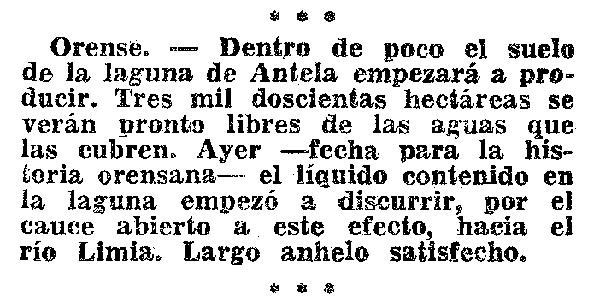
News about the completion of the canalization works of the Antela’s emissary and the beginning of the drainage of the lagoon, published in the Catalan newspaper La Vanguardia on 11-05-1962.
By admitting that works had been carried out without being approved by the Council of Ministers the General Plan for Colonisation, this Decree implicitly recognises the failure to comply with the Law of 1956 for the drainage of Antela.
Forward budgets
| Phase | Concept | Budget(1) | Updated amount(2) |
| 1st. Drainage (3) | Channelling of the river of Limia and Antela’s emissary. Main drainage channels. | 3,630,0745.99 pts | 8,233,338.52 € |
| 2nd. Transformation into irrigation | Dam of Riobó** | 86,326,385.54 pts | 19,579,607.42 € |
| Main channel** | 39,703,445.59 pts | 9,005,101.66 € | |
| Networks of ditches, drains and roads* | 127,400,000.00 pts | 28,895,475.82 € | |
| Expropriations(4) | 13,000,000.00 pts | 2,948,517.94 € | |
| 3rd. Colonisation of the lands(5) | Systematization of land(6) | 12,000,000 pts | 2,721,708.87 € |
| Rural villages**(7) | 15,000,000 pts | 3,402,136.09 € | |
| Furniture and machinery | 60,000,000 pts | 13,608,544.34 € | |
| Complementary works in the irrigation area(8) | 45,500,000 pts | 10,319,812.79 € | |
| Total | 435,228,618.12 pts | 10,319,812.79 € |
| * This work was different from the initial plan: the network of ditches was not built, but pumping stations were built in the main drainage channel. |
| ** This work was never executed. |
- Reference: “Veinte años de paz en el Movimiento Nacional bajo el mando de Franco. Provincia de Orense” (Anónimo, 1959).
- Criterion: “actualización de rentas co IPC xeral para periodos anuais completos” (http://www.ine.es/calcula/).
- It states that “the possibility of the actual cost reaching the figure of some 40 million pesetas should be envisaged”.
- Despite not indicating it, surely a part of it was for those affected by the flooding of their properties by the Riobó dam.
- It indicates, “although no budget was formulated in this regard, it can be done thanks to the experience of many other areas”.
- Calculated for scales from 3000 ha to 4000 pts/ha.
- Despite not indicating it, it was probably to relocate those displaced by the construction of the Riobó dam.
- Calculated for scales from 9100 ha to 5000 pts/ha.
Final investments (partial)
Up to now, only the final investments for the 1st phase (drainage) are collected.
| Concept | Years | Real investiment | Updated amount(1) |
| Channelling of the Limia River and emissary of Antela. Main drainage channels. | 1958-59(2) | 24,000,000.00 pts | 5,443,417.74 € |
| 1960(3) | 11,999,999.23 pts | 2,483,379.18 € | |
| 1961(4) | 11,999,999.06 pts | 2,460,338.22 € | |
| 1961(5) | 11,999,999.45 pts | 2,460,338.30 € | |
| Secondary drainage networks | 1964(6) | 12,282,873.59 pts | 2,126,250.47 € |
| Total | 72,282,871.33 pts | 14,973,717.90 € |
- Criterion: “actualización de rentas co IPC xeral para periodos anuais completos” (http://www.ine.es/calcula)
- Amount, to be confirmed, estimated considering a constant rate of investment in the 5 years of duration of these works (1958-1963) and that in the last three years at least 36 million pesetas were invested.
- Decree 1071/1960 of 2 of June.
- Decree 266/1961 of 16 February 196.
- Decree 1671/1961 of 6 September 1961.
- Resolution of the National Institute of Colonization of 5th March.
Discounting the amount of the works not executed (reservoir, irrigation channels, expropriation and rural nuclei), the budget contemplated by the drainage and colonization project of the 3243.7 ha of land “rescued for cultivation” would amount to 281,198,787 pts of the year 1958. Even without considering that this budget, as well as the execution periods, suffered the usual upward deviation characteristic of large public works and taking into account that between 1958 and 2009 incomes were multiplied by 37.8 according to the “update of incomes with the general CPI for complete annual periods” (National Institute of Statistics, http://www.ine.es/calcula), public investment at current prices would be at least 63,774,609 Euros, that is, at least 19,661 Euros/ha.
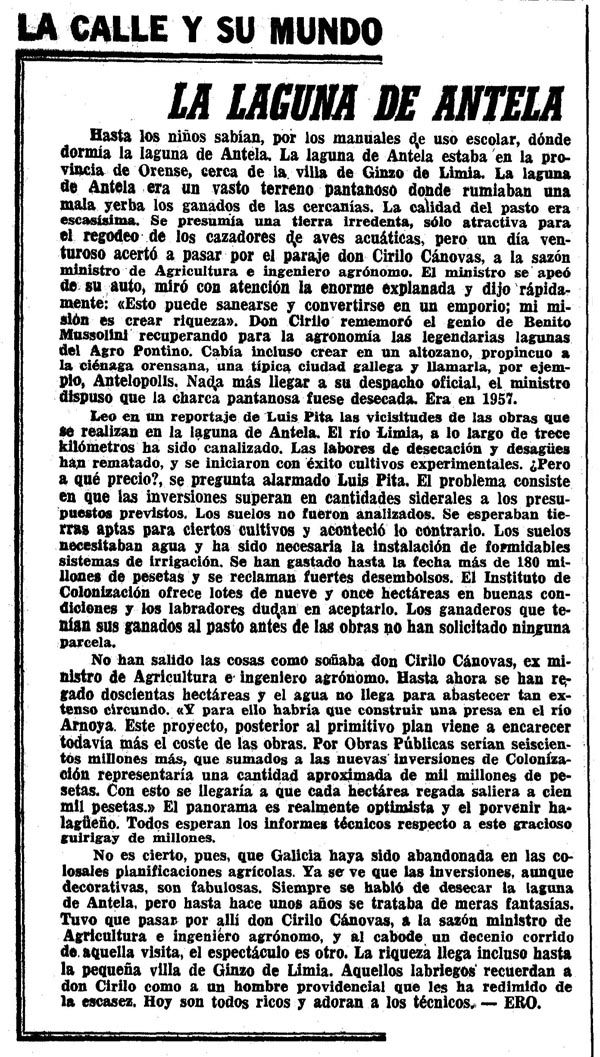
Article on the mistakes and “sideways” budgetary deviations of the Antela drainage project published in the Catalan newspaper La Vanguardia on 18-09-1968, just ten years and one day after the start of the works.
Agricultural transformation of the drained Antela
The agricultural transformation works in Antela, which had been started by the National Institute of Colonization, were continued by the National Institute for Agrarian Reform and Development (IRYDA, created by Law 35/1971 of 21 July) which applied to the lands “rescued for cultivation” the transformations “at the expense of the State” foreseen in the Law of Agrarian Reform and Development, promulgated by Decree 118/1973 of 12 January.
“Article 5.1. The Government may entrust the Institute (IRYDA), in areas or regions to be determined by Decree, with the following actions:
- a) Economic and social transformation, for reasons of national interest, of large areas, by carrying out the works required for the best use of land and water, and the creation of new farms.
- b) Arrangement of agricultural holdings so that they achieve sufficient size and appropriate socio-economic characteristics.
- c) Establishment of Improvement Plans for depressed areas. Years after IRYDA granted provisional concessions to the beneficiary farmers, in 1991, the Autonomous Government of Galicia completed the process of “rescuing for cultivation” the lands of the Lagoon of Antela by awarding ownership of the farms, and sold them to the concessionary farmers at a price of 43,066 pts/ha to be paid in 15 years, instead of the 10 years established as a maximum by article 10 of the “Special Law of Laguna de Antela”. Taking into account that between 1991 and 2009 the accumulated CPI is 82.8% (National Institute of Statistics, http://www.ine.es/calcula) this amount would currently be equivalent to 472.35 euros/ha, i.e. 2.40% of the public funds invested.
- d) Land consolidation.”
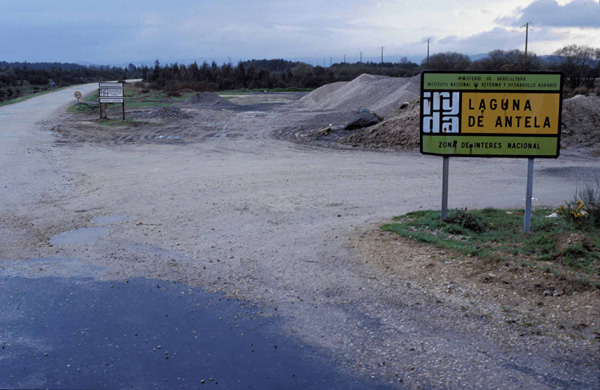
Sign of IRYDA next to the Emissary of Antela at the crossing of the N-525
The Autonomous Government of Galicia privatises the drained lagoon during Francoism
Years after IRYDA granted provisional concessions to the beneficiary farmers, in 1991 the Xunta de Galicia finished the process of “rescuing for cultivation” the lands of Antela Lagoon by awarding the meadows to the concessionary farmers at a price of 43,066 pts/ha to be paid in 15 years, instead of the 10 years established as a maximum by article 10 of the “Special Law of Laguna de Antela”. Bearing in mind that between 1991 and 2009 the accumulated CPI is 82.8% (National Institute of Statistics, http://www.ine.es/calcula) this amount is currently equivalent to 472.35 euros/ha, i.e. 2.40% of the public funds invested.
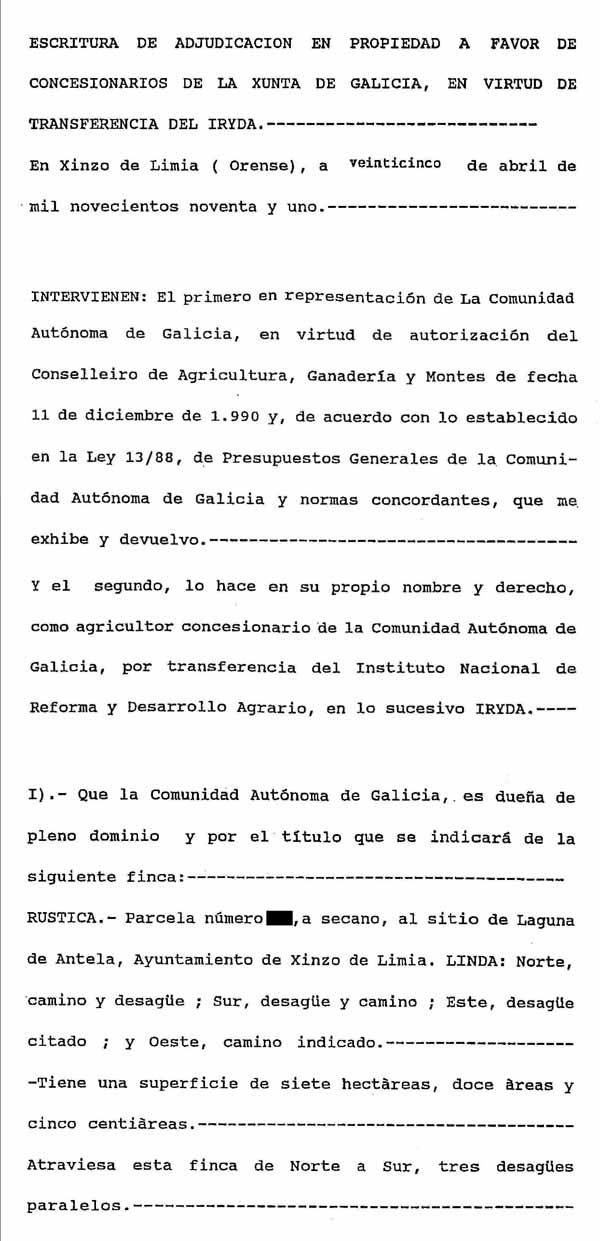
Escritura adxudicación parcela Antela (1)
Deed of assignment of the patch in Antela (1)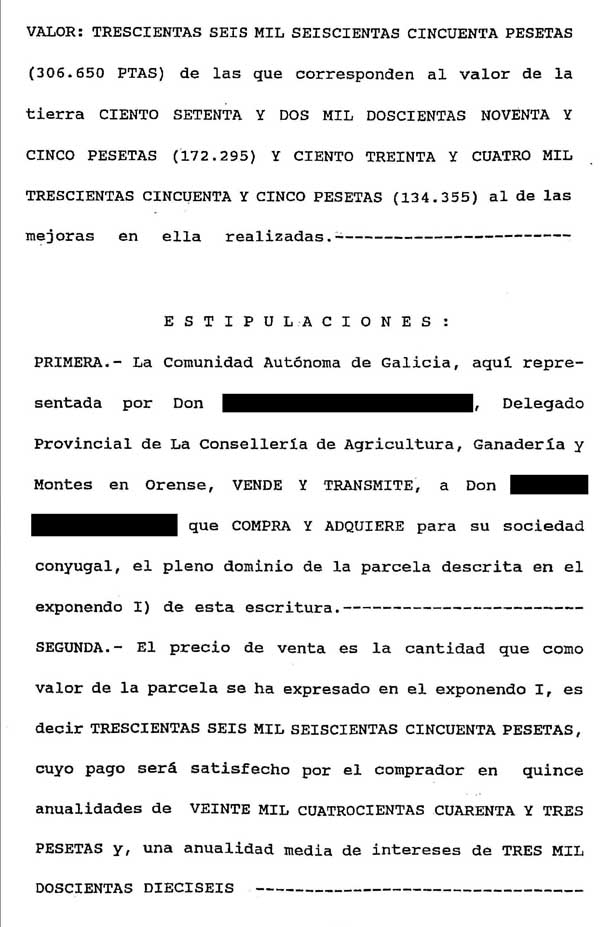
Escritura adxudicación parcela Antela (2)
Deed of assignment of the plot of land in Antela (2)
Text translated by Sara Santos Trota (student of the Degree of Translation and Interpretation of the University of Vigo)


